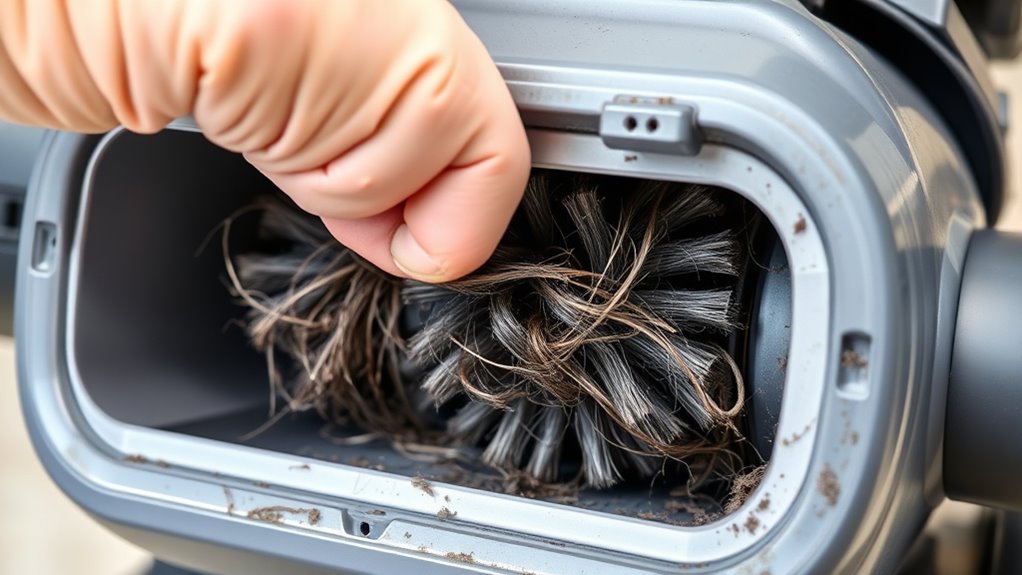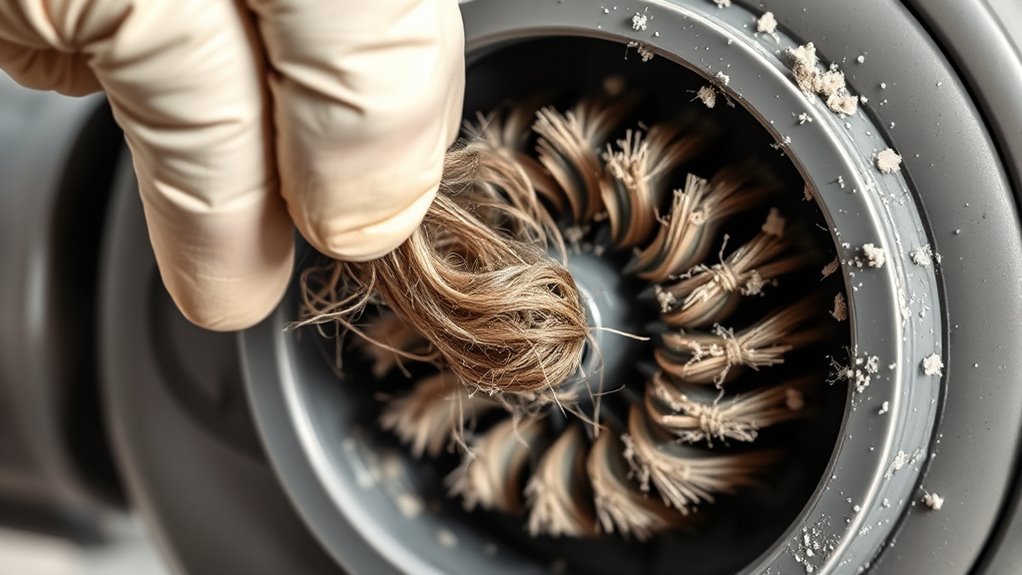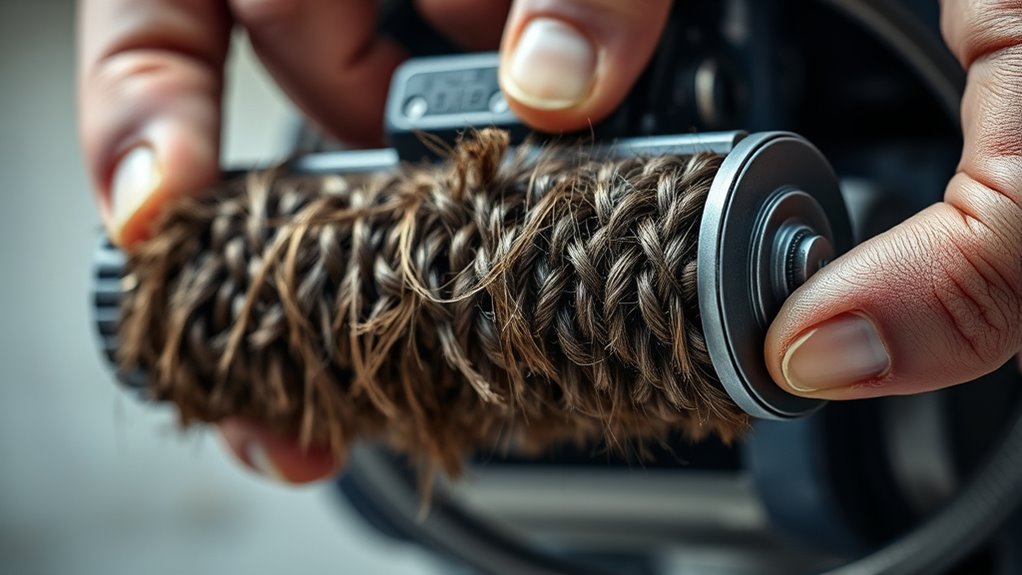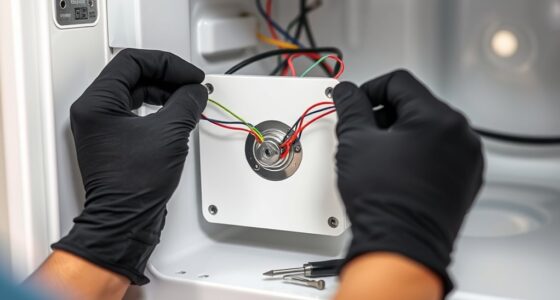To fix a slow-spinning brush roll before it fails completely, start by inspecting it for obstructions like hair or debris, which can hinder movement. Check the belt for cracks or stretching, and replace it if needed. Clean any tangled debris and apply lubricant if the brush sounds squeaky. Regular maintenance and timely replacements help prevent further damage. Keep an eye on these tips to make certain your vacuum’s longevity; more detailed guidance awaits if you keep exploring.
Key Takeaways
- Inspect the brush roll for debris, tangled hair, or obstructions that hinder spinning.
- Check the belt for cracks, fraying, or tension issues, replacing it if damaged.
- Clean the brush roll and surrounding area to remove buildup and ensure smooth movement.
- Lubricate bearings or axles if the brush feels stiff or squeaky during rotation.
- Regularly monitor and maintain the brush roll to prevent future slow-downs and motor strain.
Identifying the Signs of a Struggling Brush Roll

A slow-spinning brush roll often signals a problem that needs your attention. One common sign is uneven bristle wear, which can cause the brush to lose grip and spin sluggishly. If you notice the bristles are flattened or damaged, it indicates they aren’t making proper contact with the floor, reducing cleaning efficiency. You might also feel motor strain if the motor works harder than usual to turn the brush, often resulting in unusual noises or overheating. When the brush struggles, it puts extra stress on the motor, risking further damage. Regularly inspecting for bristle wear and listening for changes in motor performance can help you catch these issues early. Additionally, understanding projector technology can help you better maintain your vacuum’s components and ensure optimal performance. Addressing these signs promptly ensures your vacuum operates smoothly and prolongs its lifespan.
Checking for Obstructions and Debris

Obstructions and debris are common culprits behind a slow-spinning brush roll. First, inspect the brush roll for tangled hair, string, or debris that can hinder its movement. Second, check for any objects lodged between the brush and the housing, which can throw off brush roll alignment. Third, examine the surrounding area for buildup that could affect motor performance. Remove any debris carefully, ensuring the brush is free to spin smoothly. Pay attention to the brush’s alignment—misalignment can cause uneven wear or motor strain. Regularly Volkswagen Tuning checking these areas prevents further issues and keeps your vacuum operating efficiently.
Inspecting and Replacing the Belt

If your brush roll isn’t spinning properly despite a clear path, the belt might be worn or broken. Begin with a thorough belt inspection—look for cracks, fraying, or signs of stretching. If the belt appears damaged, it’s time to replace it. When installing a new belt, ensure it’s properly seated on both the motor pulley and the brush roll. Check motor alignment to guarantee the belt runs smoothly; misalignment can cause slippage or premature wear. If the belt is intact but the brush still doesn’t spin, verify that the motor pulley is secure and aligned. Correct motor alignment ensures efficient power transfer and prolongs belt life. Regular inspection and proper installation are key to keeping your brush roll spinning freely and avoiding future failures. Additionally, understanding Kia Tuning can help optimize your vehicle’s performance, similar to how maintaining your vacuum’s components ensures optimal operation.
Cleaning and Maintaining the Brush Roll

Regularly cleaning and maintaining the brush roll helps prevent buildup that can hinder its spinning ability. Start by removing debris and hair tangled around the brush to guarantee smooth rotation. Next, check the brush roll lubrication; apply a few drops of lubricant if it feels stiff or squeaky, which helps reduce friction. Additionally, always store your vacuum with the cord properly wound; this prevents strain on the motor and belt, reducing the risk of slow spinning. Vetted – 1st Home Theatre Projector can provide tips on selecting the right equipment to enhance overall cleaning performance. Following these steps keeps your brush roll in excellent condition, ensuring it spins freely and efficiently.
Preventative Tips to Keep Your Brush Roll Spinning Smoothly

To keep your brush roll spinning smoothly, adopting preventative habits is essential. Regularly check for debris and clean the brush roll to prevent buildup that can hinder rotation. Applying gentle brush roll lubrication can reduce friction and wear, helping it spin freely. Keep the brush bearings and axles well-lubricated to maintain ideal motor performance. Avoid overloading your vacuum, which strains the motor and can cause it to slow down or fail. Inspect the belt tension periodically to ensure it’s not too tight or loose, as this affects spin quality. Additionally, replace worn parts promptly to prevent further damage. Proper cleaning with suitable solutions, such as water-based paints, can also minimize residue build-up that impairs operation. By maintaining your brush roll proactively, you extend its lifespan and keep your vacuum operating at peak efficiency.
Frequently Asked Questions
Can a Slow-Spinning Brush Roll Damage My Vacuum Permanently?
A slow-spinning brush roll can cause damage to your vacuum if left unchecked, especially over time. It may strain the motor, lead to overheating, or damage internal parts. Regular vacuum maintenance and DIY repairs can help prevent this. By addressing the issue early, you avoid costly repairs and keep your vacuum running smoothly. Don’t ignore a slow-spinning brush roll—taking action now protects your vacuum’s longevity.
How Often Should I Check the Brush Roll for Issues?
Imagine you’re a detective, always on the lookout. You should check your vacuum’s brush roll every 1-3 months as part of your maintenance schedule. Regular inspections help catch issues early. Use troubleshooting tips like removing debris or hair tangled around the brush. By staying vigilant, you prevent damage and keep your vacuum running smoothly. Think of it as giving your machine a regular check-up to avoid costly repairs.
Are There Specific Tools Recommended for Cleaning the Brush Roll?
When cleaning your vacuum brush roll, you should use specific tools like vacuum brush tools and cleaning brushes designed for this purpose. These tools help remove tangled hair, fibers, and debris efficiently without damaging the roller. Using the right equipment makes the process easier and guarantees your brush roll spins freely, preventing future issues. Regular maintenance with these tools keeps your vacuum working at its best and extends its lifespan.
Will Replacing the Belt Fix All Brush Roll Speed Problems?
Did you know that 80% of brush roll issues are caused by belt problems? Replacing the belt can often fix speed issues, but it won’t always prevent motor damage if the belt has been slipping for a long time. If your brush roll is slow, a belt replacement might help, but check for motor wear too. Ignoring motor damage can lead to bigger, costlier repairs later.
Is It Safe to Repair the Brush Roll Myself or Should I Hire a Professional?
Deciding whether to do DIY repairs or hire professional assistance depends on your comfort level with appliance repairs. If you’re confident with basic tools and follow safety precautions, fixing the brush roll yourself can save money. However, for complex issues or if you’re unsure, it’s safer to seek professional assistance to avoid causing further damage. Always weigh your skills against the repair’s complexity to make the best choice.
Conclusion
By giving your brush roll the attention it needs, you keep your vacuum’s heart beating strong. Imagine it spinning freely, like a top gliding smoothly across the floor, ready to tackle dirt at a moment’s notice. With a little regular care—checking for debris, replacing worn belts, and staying vigilant—you’ll guarantee your vacuum keeps humming along, sparkling your home effortlessly. Treat your brush roll well, and it’ll reward you with spotless floors and cleaner air every time.










